
About Andrew Cusack
 Writer, web designer, etc.; born in New York; educated in Argentina, Scotland, and South Africa; now based in London.
Writer, web designer, etc.; born in New York; educated in Argentina, Scotland, and South Africa; now based in London. read more
News
Blogs
Reviews & Periodicals
Arts & Design
World
France
Mitteleuropa
Knickerbockers
Argentina
The Levant
Africa
Cape of Good Hope
Netherlands
Scandinavia
Québec
India
Muscovy
Germany
Academica
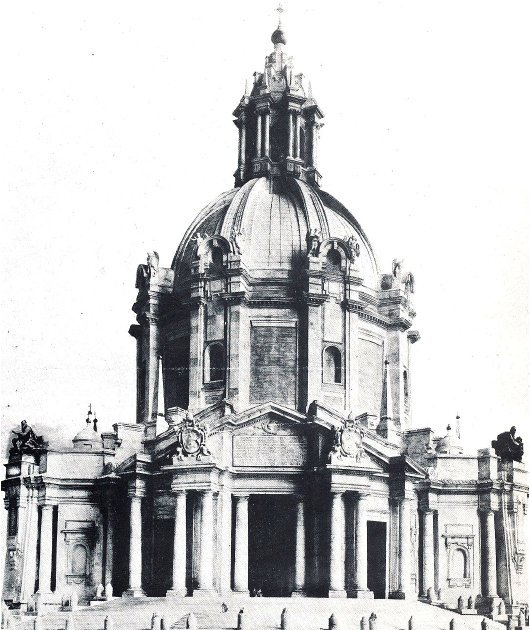
The Modern Baroque: Brasini in Parioli
The Church of the Immaculate Heart of Mary
GOOD ARCHITECTURE requires a combination of willpower, taste, and resources. This nexus used to occur quite often; instances from the Renaissance and the long nineteenth century come most easily to mind. A late twilight of this combination is found in the magnum opus of the Italian architect Armando Brasini: the Church of the Immaculate Heart of Mary in Rome’s swish Parioli neighbourhood.
The 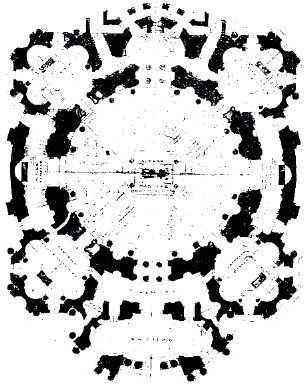 church, a modern expression of the Baroque, has somewhat curious and disjointed origins. Every age has left its imprint on Rome in one way or another: the Rome of the Republic, the Rome of the Empire, the Rome of the Popes, the Rome of the Liberals, the Rome of the Fascists, the Rome of the Italian Republic. In the 1900s, it was realised that the Church had not made a significant contribution to the great architecture of Rome for some time. Worse: the more significant structures of the past century were mostly built by the government of the Sardinian kingdom that conquered Rome and gave itself the fanciful, if geographically correct, name of ‘Italy’. A new church was needed, on a monumental scale, to be the age’s contribution to the great churches of Rome. Originally, the church was to be dedicated to St. James the Greater, but as preparations increased for the International Marian Year of 1924, it was decided the cult of the Immaculate Heart of Mary would take precedence instead.
church, a modern expression of the Baroque, has somewhat curious and disjointed origins. Every age has left its imprint on Rome in one way or another: the Rome of the Republic, the Rome of the Empire, the Rome of the Popes, the Rome of the Liberals, the Rome of the Fascists, the Rome of the Italian Republic. In the 1900s, it was realised that the Church had not made a significant contribution to the great architecture of Rome for some time. Worse: the more significant structures of the past century were mostly built by the government of the Sardinian kingdom that conquered Rome and gave itself the fanciful, if geographically correct, name of ‘Italy’. A new church was needed, on a monumental scale, to be the age’s contribution to the great churches of Rome. Originally, the church was to be dedicated to St. James the Greater, but as preparations increased for the International Marian Year of 1924, it was decided the cult of the Immaculate Heart of Mary would take precedence instead.
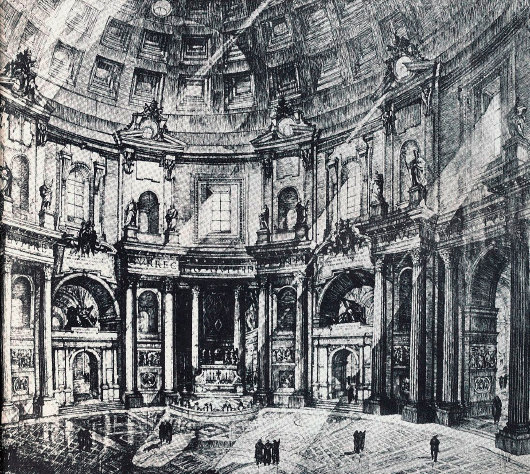
The man chosen to design this great church was Armando Brasini. He had studied at the Institute of Fine Arts but his career began to take off during the 1920s. Brasini’s study of the theatrical style of the city of Rome caught the eye of Mussolini, who commissioned architectural and urbanistic work from Brasini for the Italian colonies in North Africa (in Tripoli, a savings bank, a war memorial, and a promenade).
In 1931 he participated in the commission drafting a new master plan for Rome. We can take comfort that some of his more dramatic and radical plans never came to fruition, for example making the Trevi fountain, ideally suited for its crowded piazza, the terminus of a long avenue from the Forum. The Parioli church, however, was undoubtedly his most interesting project.
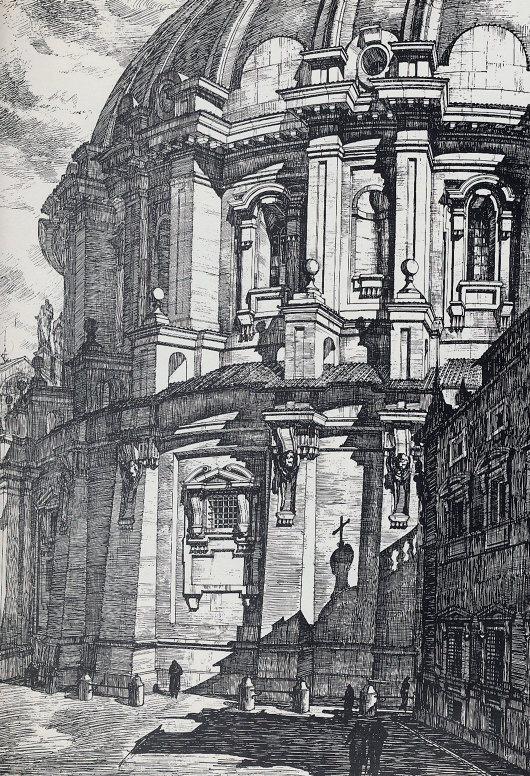
Brasini’s first design for the International Votive Church of the Immaculate Heart of Mary was exorbitantly large, and the foundations were laid in the Marian year. The crypt was completed and consecrated in 1934 and the church put into the care of the Claretians. It was then that the first of a number of plan revisions had to be made. The soggy foundations of Parioli would not support Brasini’s massive dome, so it had to be revised downwards (to the version seen atop this article).
The work continued in the 1930s but had to cease during the Spanish Civil War as the Claretians recovered from the martyrdom of 270 of their congregation. The work began again in 1939 but work was stopped again when Italy entered the World War. The redesigns, complications, and interruptions depleted the funds raised, so in the end a simple dome was built to cover the drum completed in 1951, giving the church an incomplete finality.
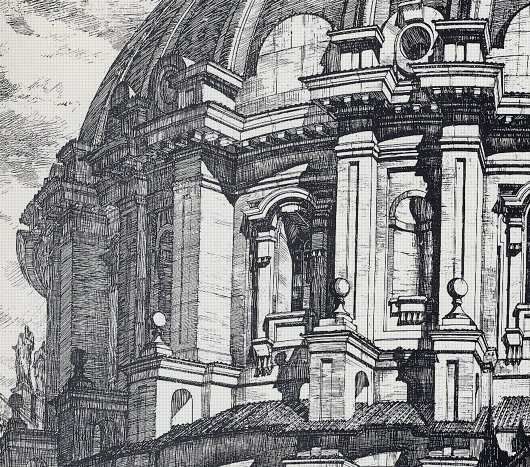
The American postmodernist architect Robert Venturi offered these words on Brasini’s Parioli creation, as completed:
What you see is a harmonius and dissonant architectural symphony of complexly layered elements — formal and symbolic, masterfully defined by shade and shadow, combining rhetoric and substance, Baroque fanfare in Palladian drag, and whose juxtapositions — or rather, collisions — of curves, rectangles, diagonals — as squat columns, gross piers, useless buttresses, eloquent walls and voids, domeless drum, protruding and receding segmented pediment — must in the end compose in the Fascist era a glorious final gesture of what can be considered Baroque survival.
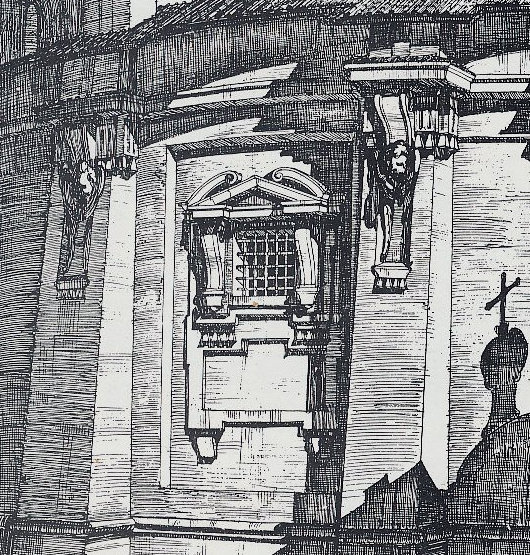
“Brasini’s work is intriguing as he applies that same vigor, bold massing and sense of experiment to the Roman Baroque.” So writes a much more reliable source of architectural knowledge, Matthew Alderman (c.f. previous mentions).
Brasini’s most interesting and most successful work… was ecclesiastical, though he also engaged in a variety of rather fanciful urban-design projects (including some very grand proposals for Rome itself, as seen above–though it is unclear to me if this predates or postdates the disastrous intervention of Mussolini in the same spot–and some odder outliers like one design for Riyadh in Arabia), public buildings, film sets, monuments (including a lighthouse-shaped monument to Christianity whose purpose still remains rather obscure to me) and even bridges. Sometimes they are more impressive than beautiful, giving a sort of unintentionally Goodhuesque strength to Roman Baroque, and others retain the delicacy of their original models, if perhaps at times developing them in intriguing new directions. While not at the level of the great masters Bernini and Borromini, and by no means a substitute for them, Brasini’s work suggests paths for a future classicism undoubtedly worth exploring.
Will Brasini’s great church at Parioli ever be completed? While it seems to easy to argue against, remember the church is not even a century old. Most of the great churches have taken several lifetimes before being finished, and even then there is a continual work of restoration and renewal. I think we ought to wait and see what the future generations decide.
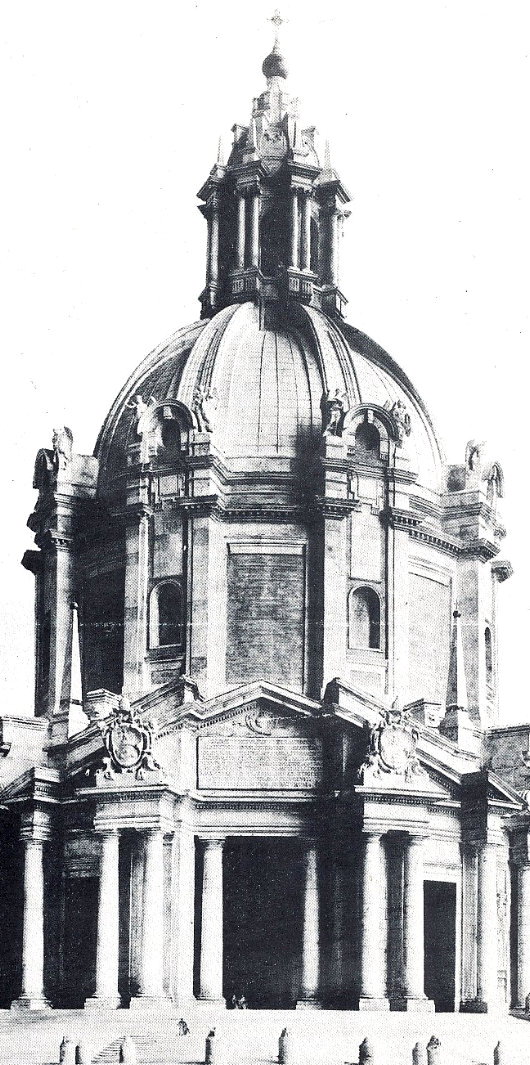
Search
Instagram: @andcusack
Click here for my Instagram photos.Most Recent Posts
- Burns Tower April 19, 2024
- Patrick in Parliament March 18, 2024
- Articles of Note: 13 March 2024 March 13, 2024
- Cambridge March 9, 2024
- Taken on Trust March 4, 2024
Most Recent Comments
Book Wishlist
Monthly Archives
Categories



Very beautiful and interesting designs. I had no idea there was to be anything this interesting in Parioli. I hope it does get finished.
Thanks, this was a piece of architecture I knew nothing about. Now I need to find a picture of what was built.
A picture of the church as it is.
http://it.wikipedia.org/wiki/File:Pinciano_-_S._Cuore_Immacolato_di_Maria.JPG